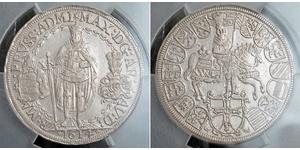1 Thaler (Verkauft für $430.0)
1642, Augsburg (Free City), Ferdinand III. Silver "City-View" Thaler Coin. Rare!
Mint year: 1642 Denomination: Thaler Reference: Davenport 5039A, KM-77. R! Mint Place: Augsburg (as free City within the Holy Roman Empire). Condition: Welding scars and tooling marks at 3 and 6 o'clock in obverse (where a pin was once welded as this coin was used as a brooch), otherwise a nice XF-AU with great details! Weight: 28.86gm Diameter: 43mm Material: Silver
Obverse: Draped, armored and laureated bust of Ferdinand III right, lion´s face inside shoulder drapery. Legend: * IMP : CAES : FERD : III . P . F . GER . HVN : BOH : REX .
Reverse: Winged cupid´s face above city view and Pyr of Augsburg (Pine cone) in foreground, splitting date (16-42). Legend: . AVGVSTA . VIN (three horse-shoes) DELICORVM .
Augsburg is an independent city in the south-west of Bavaria. The College town is home of the Regierungsbezirk Schwaben and also of the Bezirk Schwaben and the Landkreis Augsburg. In 1906 Augsburg became a Großstadt (city), and is currently the third-largest city in Bavaria with more than 264,000 citizens. Only Munich and Nuremberg are larger. The name of the city dated from the Roman settlement Augusta Vindelicorum. The city was founded by the Roman emperor Augustus 15 BC as a castra. Therefore the "Fuggerstadt" is the second oldest city in Germany after Trier. In 1530 the Augsburg Confession was presented to the Holy Roman Emperor at the Diet of Augsburg. Following the Peace of Augsburg in 1555, after which the rights of religious minorities in imperial cities were to be protected, a mixed Catholic–Protestant city council presided over a majority Protestant population; see Paritätische Reichsstadt (German). Until the Thirty Years' War (1618–1648), religious peace in the city was largely maintained despite increasing confessional tensions. In 1629, Ferdinand II issued the Edict of Restitution resulting in the installation of an entirely Catholic city government that radically curtailed the rights of local Protestants. This persisted until April 1632, when the Swedish army of Gustavus Adolphus took the city without resistance. Just over two years later, the Swedish army was routed at nearby Nördlingen, and by October 1634 Catholic troops had surrounded Augsburg. The Swedish garrison refused to surrender and a disastrous siege ensued through the winter of 1634–5, during which thousands died of hunger and disease. These difficulties, together with the discovery of America, and of the route to India by the Cape, conspired to destroy the town's prosperity.
Ferdinand III (July 13, 1608 – April 2, 1657) was Holy Roman Emperor February 15, 1637 – 1657. King of Hungary, King of Bohemia, Archduke of Austria, King of the Romans.
Eldest son of Emperor Ferdinand II from the house of Habsburg and his first wife, Maria Anna of Bavaria. Made King of Hungary in 1625, King of Bohemia in 1627, Archduke of Austria in 1621 and succeeded his father King of the Romans in 1636, and thence Holy Roman Emperor 1637.
Following the death of Wallenstein in 1634, he was made titular head of the Imperial Army in the Thirty Years' War, and later that year joined with his cousin the Cardinal-Infante to defeat the Swedes at Nördlingen. Leader of the peace party at court, he helped negotiate the Peace of Prague with the Protestant States, especially Saxony in 1635.
He succeeded his father as Holy Roman Emperor in 1637. He hoped to be able to make peace soon with France and Sweden, but the war dragged on for another 11 years, finally coming to an end with the Peace of Westphalia (Treaty of Münster with France, Treaty of Osnabrück with Sweden) in 1648, both negotiated by his envoy Maximilian von und zu Trauttmansdorff, a successful diplomat who had been made a count in 1623 by his father Ferdinand II, Holy Roman Emperor.
During the last dreadful period of the war, in 1644 Ferdinand III gave to all rulers of German states the right to conduct their own foreign policy (ius belli ac pacis). This way the emperor was trying to gain more allies in the negotiations with France and Sweden. This very edict contributed to the gradual erosion of the imperial authority in the Holy Roman Empire.
In the Peace of Westphalia, his full titles are given as: "Ferdinand the Third, elected Roman Emperor, always August, King of Germany, Hungary, Bohemia, Dalmatia, Croatia, Slavonia, Archduke of Austria, Duke of Burgundy, Brabant, Styria, Carinthia, Carniola, Margrave of Moravia, Duke of Luxemburg, of the Higher and Lower Silesia, of Wurtemburg and Teck, Prince of Swabia, Count of Habsburg, Tyrol, Kyburg and Goritia, Marquess of the Sacred Roman Empire, Burgovia, the Higher and Lower Lusace, Lord of the Marquisate of Slavonia, of Port Naon and Salines."

|
Beigetragen von:
anonymous 2019-07-24 |
|
||
|
||
|
||
|
||
|
||
1 Leu Königreich Rumänien (1881-1947) Silber Karl I. (Rumäni ...
Diese Gruppe hat 7 Münzen / 5 Preise
⇑

-600-300-3lBY_n9Nq08AAAFsuJLENSKZ.jpg)

-300-150-RxkKb0OM_CMAAAFFpKWrXbSq.jpg)
 Deutsch
Deutsch Русский
Русский Українська
Українська English
English Italiano
Italiano Français
Français Español
Español 汉语
汉语






-300-150-_6kKbzbi9vgAAAFRc52Wyns9.jpg)






